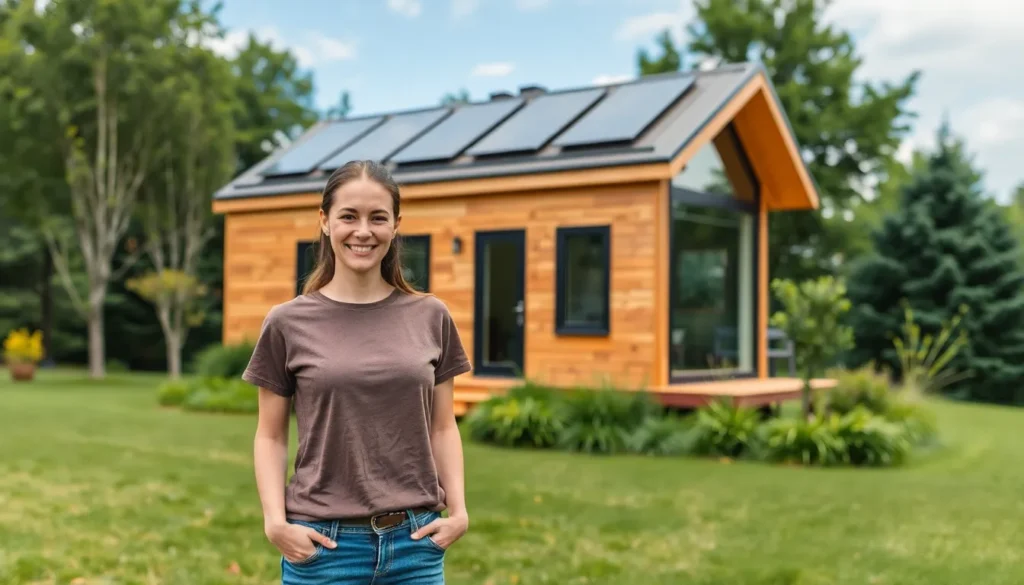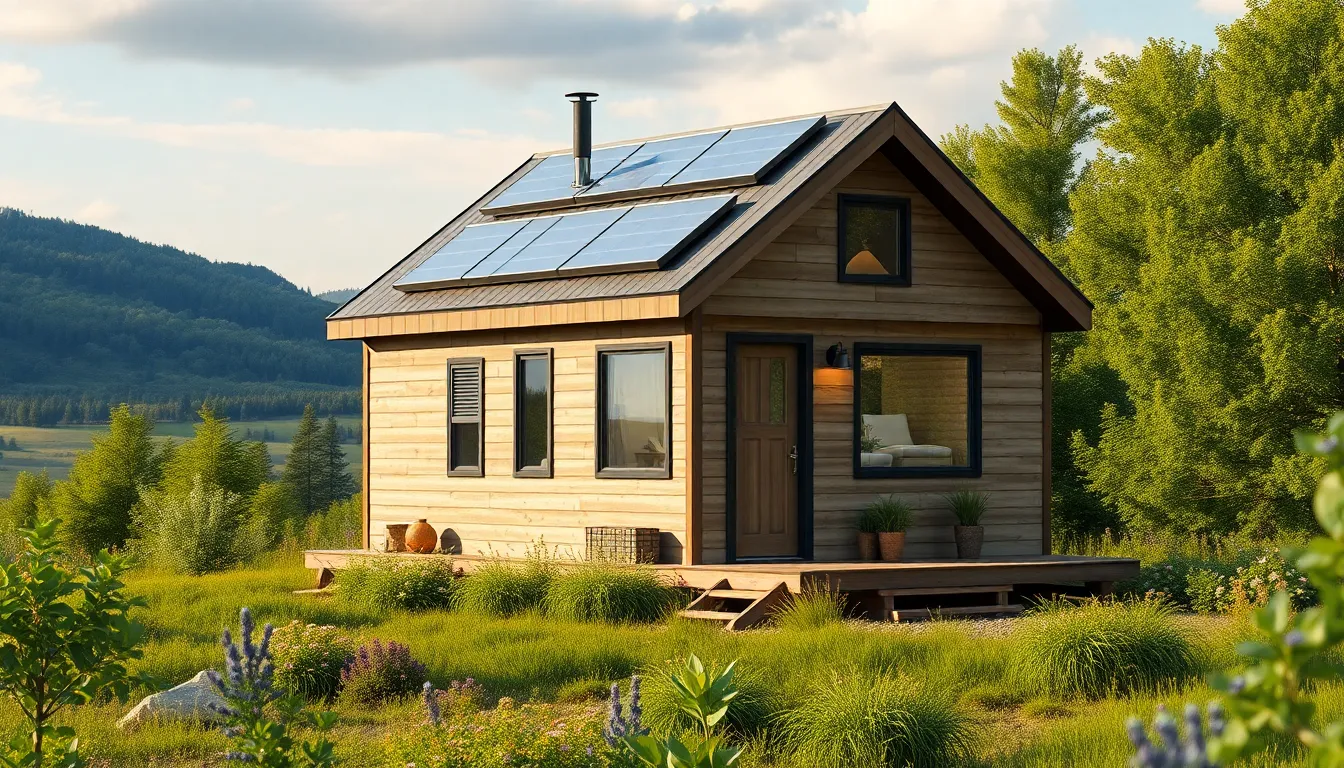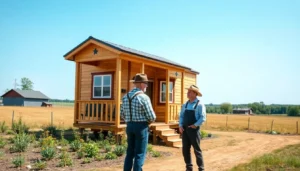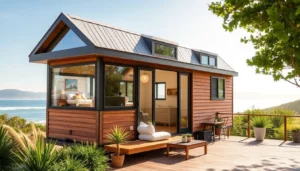Table of Contents
ToggleImagine living in a cozy, stylish space that’s not only good for your wallet but also for the planet. Eco-friendly tiny homes are popping up everywhere, and for good reason. They offer a sustainable lifestyle without sacrificing comfort or style. Who wouldn’t want to downsize their carbon footprint while maximizing their living space?
These pint-sized powerhouses are designed with efficiency in mind, making them perfect for those who crave simplicity. Picture yourself sipping coffee on your eco-deck, surrounded by nature, while your tiny home runs on solar power. It’s like living in a Pinterest board come to life! Plus, you’ll have more time to enjoy the little things in life—like not worrying about a mortgage the size of a small country. Dive into the world of eco-friendly tiny homes and discover how you can embrace a greener, simpler lifestyle.
Overview of Eco-Friendly Tiny Homes
Eco-friendly tiny homes represent a growing trend that combines minimalist living with sustainable practices. These homes often utilize renewable resources, making them energy-efficient and environmentally friendly options. Increased interest in this lifestyle stems from various factors, including rising housing costs and a desire for reduced environmental impact.
Design typically maximizes space while incorporating eco-friendly materials like salvaged wood and recycled steel. Energy sources include solar panels and wind turbines, allowing occupants to harness natural energy and minimize dependency on traditional power grids. Many tiny homes feature green roofs, which support biodiversity and mitigate stormwater runoff.
Water conservation plays a crucial role in these dwellings. Rainwater harvesting systems collect and store water, while composting toilets reduce waste and conserve water. Innovative storage solutions enhance functionality, ensuring residents can live comfortably without excessive possessions.
Communities of tiny home enthusiasts often emphasize shared resources, promoting sustainable living practices. These networks foster connections among like-minded individuals, allowing them to share knowledge on building, renovating, and experiencing tiny living. Access to workshops and collaborative projects strengthens communal ties, promoting eco-conscious practices.
The aesthetic appeal of eco-friendly tiny homes further drives their popularity. Often designed with large windows and open spaces, these homes create a seamless connection with nature. Residents enjoy the tranquility and beauty of their surroundings, enhancing the overall living experience.
By embracing this innovative housing solution, individuals and families access a simpler, more sustainable way of life, making significant strides toward reducing their environmental footprint.
Benefits of Eco-Friendly Tiny Homes
Eco-friendly tiny homes offer numerous advantages, particularly for those seeking sustainability and financial efficiency.
Reduced Environmental Impact
Eco-friendly tiny homes significantly lessen environmental damage. These compact structures utilize renewable energy sources like solar panels and wind turbines. Such features lead to lower greenhouse gas emissions compared to traditional homes. Materials used in construction often include recycled and sustainable products, reducing waste. Water conservation practices, like rainwater harvesting, minimize water usage and protect local ecosystems. By prioritizing efficiency, these homes encourage environmentally-conscious living. A smaller living space also requires fewer resources for heating and cooling, further decreasing energy consumption. Overall, eco-friendly tiny homes present a viable option for individuals aiming to lessen their ecological footprint.
Cost Savings
Cost savings represent a major benefit of eco-friendly tiny homes. Lower utility costs arise from energy-efficient designs and the use of renewable energy sources, such as solar power. Reduced property taxes often accompany smaller homes, allowing for more accessible homeownership. Affordability increases through the decreased need for extensive maintenance and repairs, which frequently burden larger homes. With simplified living, individuals spend less on furnishings and renovations. Many ecologically-minded homeowners share resources and knowledge, creating a supportive community focused on frugality. Overall, eco-friendly tiny homes provide a pathway to saving money while embracing a sustainable lifestyle.
Design Features of Eco-Friendly Tiny Homes
Eco-friendly tiny homes incorporate innovative design features promoting sustainability. These homes highlight efficient use of space while ensuring comfort and aesthetic appeal.
Sustainable Materials
Sustainable materials form the backbone of eco-friendly tiny homes. Reclaimed wood, bamboo, and recycled metals feature prominently in construction. These materials reduce the carbon footprint while enhancing durability. Locally sourced products also diminish transportation emissions, offering a dual advantage. Moreover, natural insulation options, like wool and cellulose, improve energy efficiency while maintaining air quality. Prioritizing these materials contributes to creating healthier indoor environments.
Energy Efficiency
Energy efficiency defines the core of eco-friendly tiny homes. Solar panels provide a renewable energy source, reducing reliance on fossil fuels. High-performance windows enhance insulation, minimizing heating and cooling needs. Additionally, energy-efficient appliances lower electricity consumption, leading to significant cost savings. Incorporating rainwater harvesting systems further promotes eco-conscious living by conserving water. These homes cleverly integrate smart technology, optimizing energy use and encouraging sustainable habits.
Challenges in Eco-Friendly Tiny Homes
Eco-friendly tiny homes face several challenges that potential owners must consider. Space limitations serve as a primary concern as these homes prioritize efficiency over square footage.
Space Limitations
Space limitations significantly impact the design and functionality of tiny homes. Owners often navigate creative storage solutions, balancing minimalism with essential living needs. Optimizing small areas without sacrificing comfort proves essential for daily living. Multi-functional furniture, like fold-out tables or convertible sofas, maximizes utility in compact spaces. Additionally, individuals may struggle to accommodate personal belongings or increased family size, leading to potential constraints in future growth.
Zoning and Regulations
Zoning and regulations pose hurdles for tiny home enthusiasts. Many locations impose strict zoning laws that limit where tiny homes can legally reside. Building codes often require specific foundation types and may restrict alternative housing options. Inspections and permits can result in increased costs and time delays. Living in areas with lenient regulations, such as tiny home communities or designated eco-villages, simplifies challenges. However, these options may not be readily available depending on geographic location, complicating the dream of sustainable living.
Popular Eco-Friendly Tiny Home Models
Tiny homes come in various models, each blending sustainability with innovative design. The Timbercraft Tiny Homes model features a contemporary design with a focus on natural materials, incorporating reclaimed wood and energy-efficient components.
Another notable option is the Tumbleweed Tiny House Company, which offers customizable designs tailored to individual needs, highlighting space efficiency and sustainability. These homes often include solar panels and water conservation systems to minimize environmental impact.
Mighty Small Homes stands out for its commitment to green technology, focusing on eco-friendly materials like bamboo and recycled steel. This model emphasizes minimal energy consumption while maximizing comfort and style.
A popular choice among tiny home enthusiasts, HAUS, Tiny House Company, specializes in modular designs that use local materials, reducing the carbon footprint and enhancing structural integrity. These homes typically feature large windows to create a connection to nature and improve indoor light.
Escape Traveler presents a unique take on tiny living with its portable tiny homes, designed for easy relocation while maintaining energy efficiency. Their use of energy-saving appliances aligns well with eco-friendly values.
Moreover, Nano Homes emphasizes affordability and sustainability, making them suitable for wider audiences. These compact models focus on reducing waste during construction and using eco-conscious materials.
Many models prioritize integration with nature, providing outdoor living spaces and gardens that promote biodiversity. The appeal of these eco-friendly tiny homes lies in their innovative designs, which make sustainable living not just a choice but a lifestyle.
Conclusion
Eco-friendly tiny homes represent a transformative shift in how individuals approach living spaces. They offer a unique blend of sustainability and style that resonates with those seeking a simpler lifestyle. By prioritizing energy efficiency and environmentally friendly materials, these homes not only reduce one’s carbon footprint but also provide significant financial savings.
The sense of community among tiny home enthusiasts fosters a supportive environment that encourages eco-conscious living. As the trend continues to grow, more people are discovering the benefits of embracing this innovative housing solution. Ultimately, eco-friendly tiny homes pave the way for a future where sustainable living is both attainable and enjoyable.








